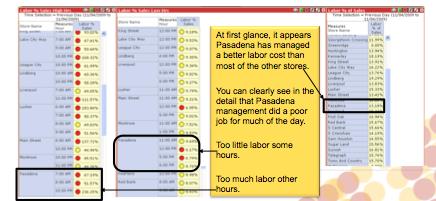Reasons Why Operators Should Mind (and Mine) Their Big Data (Part 1 of 2)
08 July 2015
 Real information power comes when operators begin to consolidate and review all their data, to reveal the complete picture they need to make better business decisions.
Real information power comes when operators begin to consolidate and review all their data, to reveal the complete picture they need to make better business decisions.
By Dave Bennett
Culinary educators know their students seek out the foodservice industry for many reasons: They simply love to cook, they excel in the high-energy foodservice environment and they see long-term career potential and an opportunity to make a name for themselves.
Few, if any, culinary students will profess they are in it for the statistics.
Minding the numbers goes beyond containing food or labor costs. Effectively leveraging restaurant information can be the key to profit and financial success. It can be the difference between driving defensively, stuck forever in the right lane, versus pulling away from gridlock to lead the competition.
There are three main reasons that operators should mind (and mine) their business data. This article will address two of those reasons; the third reason will be covered in the second article in this series.
#1: Information is power
Harnessing a restaurant business’ information can, and should, ultimately increase earnings. Information is power, power that can be converted into dollar signs. The trick is to learn how to put that information to its best use.
Every restaurant operation is already generating some level of information. This includes data from transactional systems—point of sale, inventory, drive through and the like—as well as payroll systems, accounts payable, even mystery-shopper and customer-loyalty programs.
By maximizing the quantity of information that is collected, and by analyzing that information to learn all its lessons, operators can ultimately increase their earnings and grow their businesses.
Here’s a small example of the power that information can provide: Let’s say a chain adds a new menu item. To promote sales of that new item, the chain can study the “early adopter” customers who buy it. What else do those customers buy, in addition to the new menu item? Promote those items to drive greater sales of the new item with other customers.
#2: Information power is within reach
Big Data has been getting a lot of press lately, largely because most businesses haven’t yet been able to extract real value from all that massive potential. The foodservice industry shouldn’t let that discourage us; information power is within our reach today, with more to come in the future.
How does one learn information power? All learning takes place on a curve, and learning from restaurant information is no exception. (See the graphic below.)
While some operators think their transactional systems give them all the information they need, in fact transactional data is the bottom or foundation of the information learning curve. Why? Because while transactional data is useful, it is locked in silos. Transactional systems typically don’t speak with one another, so operators can only look at one type of transactional data at a time, isolated from other types. For example, it’s not possible to evaluate the relationship between a loyalty-program event from one transactional system and limited-time offer (LTO) sales from another, or between the speed of an understaffed kitchen and table turns when only looking at labor data.
Real information power comes when operators begin to consolidate and review all their data, to reveal the complete picture they need to make better business decisions. Transactional systems generate data. Analytical systems organize and understand all that data, identifying relationships across data sets that will provide the insights business managers need to make smart decisions.
Analytical systems answer a progressive series of questions: What happened? Was that good or bad? Why did it happen? Can we make it happen again? The ultimate goal of the information learning curve is getting to the point where an operator can forecast how to repeat a good thing.

For example, a store’s labor percentages might indicate that it is beating goals; however, if you’re not also comparing labor percentage to the store’s high- and low-volume sales hours, you might not be seeing the whole picture. This might lead the store manager to make labor decisions that negatively impact sales. The following graphic depicts an example of this; the Pasadena store has a better labor percentage than others in its district. But when that overall labor percentage is compared to high and low sales hours, we can see that the Pasadena unit was understaffed at critical hours and overstaffed during some lower-volume hours.

How to harness information power
To fully harness the power of restaurant information, operators must first identify where they are on the information learning curve.
Baseline, are they already putting to work the lessons they can learn from their transactional systems? If no, they should learn to walk before they run. (Or to continue our car analogy, they should accelerate through first gear before shifting to second.)
If yes, then they are ready to move on to more sophisticated learning that comes from consolidating and reviewing their data sets, and the understanding and management support that can result.
Mastering the information curve is a long-term process, not a short-term project. Long-distance drivers know the fun is often in what you see and learn along the journey. Meanwhile, operators should keep in mind that where they are on the learning curve at a particular point in time colors their perception of their business. That perception will change dramatically as they progress through the learning curve.
Part two of this article series will:
- Reveal the third reason to mind (and mine) restaurant data.
- Offer tips to progress along the information learning curve.
- Explore an important tool for mining your Big Data: exception-based reporting.
- Advise where to find help mastering your restaurant information—because you aren’t alone out there.
Dave Bennett is CEO of Mirus Restaurant Solutions, a pioneer in cloud-based restaurant reporting and analysis systems before the cloud was cool. He has more than 30 years of experience in restaurant technology and information management.
